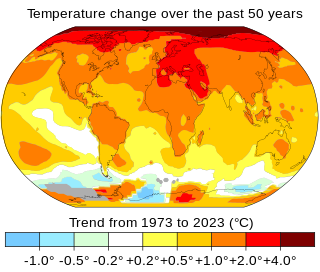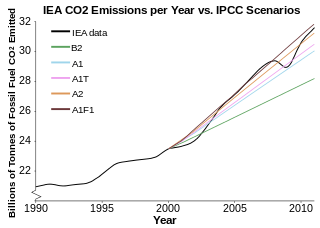ਆਲਮੀ ਤਪਸ਼
ਆਲਮੀ ਤਪਸ਼ ਜਾਂ ਸੰਸਾਰੀ ਤਾਪ ਜਾਂ ਗਲੋਬਲ ਵਾਰਮਿੰਗ (English: global warming) ਪਿਛੇਤਰੀ 19ਵੀਂ ਸਦੀ ਤੋਂ ਲੈ ਕੇ ਧਰਤੀ ਦੇ ਹਵਾਮੰਡਲ ਅਤੇ ਮਹਾਂਸਾਗਰਾਂ ਦੇ ਔਸਤ ਤਾਪਮਾਨ ਵਿੱਚ ਆਏ ਅਤੇ ਭਵਿੱਖ ਵਿੱਚ ਆਉਣ ਵਾਲ਼ੇ ਵਾਧੇ ਨੂੰ ਆਖਿਆ ਜਾਂਦਾ ਹੈ। ਅਗੇਤਰੀ 20ਵੀਂ ਸਦੀ ਦੇ ਪਹਿਲੇ ਦਹਾਕੇ ਵਿੱਚ ਧਰਤੀ ਦੀ ਸਤ੍ਹਾ ਦਾ ਔਸਤ ਤਾਪਮਾਨ 0.99°C ਤੇ 2011-20 ਦੇ ਦਹਾਕੇ ਵਿੱਚ
1.1 °C , 1850-1900 ਦੇ ਔਸਤ ਤਾਪਮਾਨ ਤੋਂ ਵਧ ਗਿਆ ਹੈ ਜਿਸ ਵਿਚੋਂ ਲਗਭਗ ਦੋ-ਤਿਹਾਈ ਵਾਧਾ 1980 ਤੋਂ ਹੁਣ ਤੱਕ ਹੋਇਆ ਹੈ।[2] [3] ਪੌਣਪਾਣੀ ਦੀ ਤਬਦੀਲੀ ਬਾਰੇ ਅੰਤਰਸਰਕਾਰੀ ਪੈਨਲ (IPCC) ਨੇ ਸਿੱਟਾ ਕਢਿਆ ਹੈ ਕਿ 20 ਵੀਂ ਸਦੀ ਦੇ ਮਧ ਤੋਂ ਸੰਸਾਰ ਦੇ ਔਸਤਨ ਤਾਪਮਾਨ ਵਿੱਚ ਵਾਧਾ ਮੁੱਖ ਤੌਰ 'ਤੇ ਐਂਥਰੋਪੋਜੈਨਿਕ (anthropogenic) (ਮਨੁੱਖ ਨਿਰਮਿਤ) ਗਰੀਨਹਾਊਸ ਗੈਸਾਂ ਦੀ ਵਧ ਰਹੀ ਮਾਤਰਾ ਕਰ ਕੇ ਹੋਇਆ ਗਰੀਨਹਾਊਸ ਅਸਰ ਹੈI 90% ਤੋਂ ਵੱਧ ਵਿਗਿਆਨੀ ਇਸ ਗੱਲ ਨਾਲ ਸਹਿਮਤ ਹਨ ਇਹਦਾ ਕਾਰਨ ਵਧੇਰੇ ਤੋਂ ਵਧੇਰੇ ਵਰਤੇ ਜਾ ਰਹੇ ਪਥਰਾਟ ਬਾਲਣ ਅਤੇ ਜੰਗਲਾਂ ਦੀ ਕਟਾਈ ਵਰਗੀਆਂ ਮਨੁੱਖੀ ਸਰਗਰਮੀਆਂ ਹਨ।[4][5][6][7][8] ਇਨ੍ਹਾਂ ਗੱਲਾਂ ਨੂੰ ਸਾਰੇ ਵੱਡੇ ਉਦਯੋਗਿਕ ਦੇਸ਼ਾਂ ਦੀਆਂ ਰਾਸ਼ਟਰੀ ਵਿਗਿਆਨ ਅਕਾਦਮੀਆਂ ਮੰਨਦੀਆਂ ਹਨ।[9] ਜਵਾਲਾਮੁਖੀ ਦੇ ਨਾਲ ਮਿਲ ਕੇ ਸੌਰ ਤਬਦੀਲੀ (solar variation) ਵਰਗੀਆਂ ਕੁਦਰਤੀ ਘਟਨਾਵਾਂ 1950 ਤੋਂ ਪਹਿਲਾਂ ਵਾਲੇ ਉਦਯੋਗਕ ਕਾਲ ਤੱਕ ਘੱਟ ਗਰਮੀ ਦੇ ਪ੍ਰਭਾਵ ਵਿਖਾਈ ਦਿੰਦੇ ਸਨ ਅਤੇ 1950 ਦੇ ਬਾਅਦ ਇਸ ਦੇ ਠੰਡਾ ਹੋਣ ਦੇ ਘੱਟ ਪ੍ਰਭਾਵ ਵਿਖਾਈ ਦਿੰਦੇ ਸਨ।
ਪ੍ਰਭਾਵ
[ਸੋਧੋ]ਅੱਠ ਅਕਤੂਬਰ ਨੂੰ ਦੱਖਣੀ ਕੋਰੀਆ ਵਿੱਚ ਮੌਸਮੀ ਤਬਦੀਲੀ ਬਾਰੇ ਇੰਟਰ-ਗਵਰਨਮੈਂਟਲ ਪੈਨਲ ਫ਼ਾਰ ਕਲਾਈਮੇਟ ਚੇਂਜ (ਆਈਪੀਸੀਸੀ) ਨੇ 400 ਪੰਨਿਆਂ ਦੀ ਰਿਪੋਰਟ ਜਾਰੀ ਕੀਤੀ ਹੈ। ਇਸ ਵਿੱਚ ਕਿਹਾ ਗਿਆ ਹੈ ਕਿ ਜੇ ਗਰੀਨ ਹਾਊਸ ਗੈਸਾਂ ਦਾ ਨਿਕਾਸ ਤੇਜ਼ੀ ਨਾਲ ਨਾ ਘਟਾਇਆ ਤਾਂ ਤਾਪਮਾਨ ਵਾਧੇ ਭਿਆਨਕ ਅਸਰ ਸਾਹਮਣੇ ਆਉਣਗੇ। ਇਹ ਅਸਰ ਧਰਤੀ ਅਤੇ ਸਮੁੰਦਰ ਵਿਚਲੀ ਹਰ ਤਰ੍ਹਾਂ ਦੀ ਜ਼ਿੰਦਗੀ ਲਈ ਘਾਤਕ ਹੋਣਗੇ। ਇਹ ਵੀ ਕਿਹਾ ਗਿਆ ਹੈ ਕਿ ਜੇ ਗਰੀਨ ਹਾਊਸ ਗੈਸਾਂ ਦੀ ਨਿਕਾਸੀ ਮੌਜੂਦਾ ਪੱਧਰ ਉੱਤੇ ਹੀ ਬਰਕਰਾਰ ਰਹੀ ਤਾਂ 2030 ਤੋਂ 2052 ਦੇ ਦਰਮਿਆਨ ਧਰਤੀ ਦਾ ਔਸਤ ਤਾਪਮਾਨ ਸਨਅਤੀਕਰਨ ਤੋਂ ਪਹਿਲਾਂ ਦੇ 1.5 ਡਿਗਰੀ ਸੈਲਸੀਅਸ ਅਤੇ ਸਦੀ ਦੇ ਅੰਤ ਤੱਕ ਧਰਤੀ 3 ਤੋਂ 4 ਡਿਗਰੀ ਸੈਲਸੀਅਸ ਦੇ ਵਾਧੇ ਨਾਲ ਤਪਣ ਲੱਗੇਗੀ।
ਇਹ ਰਿਪੋਰਟ 91 ਵਿਗਿਆਨੀਆਂ ਨੇ 40 ਮੁਲਕਾਂ ਦੇ ਹਜ਼ਾਰਾਂ ਮਾਹਿਰਾਂ ਅਤੇ ਸਮੀਖਿਅਕਾਂ ਦੀ ਮਦਦ ਨਾਲ ਤਿਆਰ ਕੀਤੀ ਹੈ। 2015 ਦੀ ਪੈਰਿਸ ਜਲਵਾਯੂ ਸੰਧੀ ਵੇਲੇ ਧਰਤੀ ਉੱਤੇ ਤਾਪਮਾਨ ਦੇ ਵਾਧੇ ਦੀ ਸੁਰੱਖਿਅਤ ਸੀਮਾ ਦਾ ਮੁੱਦਾ ਚਰਚਿਤ ਰਿਹਾ ਸੀ ਕਿਉਂਕਿ ਵਿਕਸਿਤ ਮੁਲਕ ਇਸ ਨੂੰ ਸਨਅਤੀ ਇਨਕਲਾਬ ਦੇ ਔਸਤ ਤਾਪਮਾਨ ਤੋਂ 2 ਡਿਗਰੀ ਸੈਲਸੀਅਸ, ਜਦਕਿ ਛੋਟੇ ਛੋਟੇ ਟਾਪੂਆਂ ਉੱਤੇ ਸਥਿਤ ਅਤੇ ਘੱਟ ਵਿਕਸਿਤ ਮੁਲਕ 1.5 ਡਿਗਰੀ ਸੈਲਸੀਅਸ ਜਾਂ ਉਸ ਤੋਂ ਵੀ ਘੱਟ ਵਾਧੇ ਨੂੰ ਸੁਰੱਖਿਅਤ ਸੀਮਾ ਮੰਨਦੇ ਸਨ ਕਿਉਂਕਿ ਛੋਟੇ ਛੋਟੇ ਟਾਪੂਆਂ ਉੱਤੇ ਮਾਲਦੀਵਜ਼, ਕੀਰੀਬਾਤੀ ਵਰਗੇ ਬਹੁਤ ਸਾਰੇ ਮੁਲਕਾਂ ਦਾ ਵਜੂਦ ਸਮੁੰਦਰ ਦੇ ਜਲ ਸਰੋਤ ਦੇ ਇੱਕ ਮੀਟਰ ਉੱਚਾ ਹੋਣ ਨਾਲ ਹੀ ਖ਼ਤਮ ਹੋ ਜਾਵੇਗਾ।[10]
ਸਾਇੰਸਦਾਨ ਸੁਨੀਤਾ ਨਾਰਾਇਨਣ ਮੁਤਾਬਕ ਵਾਤਾਵਰਣ ਵਿੱਚ 1870 ਤੋਂ ਹੁਣ ਤੱਕ ਅਨੁਮਾਨ ਮੁਤਾਬਕ 1.1 ਡਿਗਰੀ [11]ਤਾਪਮਾਨ ਵਧਿਆ ਹੈ [12]ਜਿਸ ਦੇ ਪ੍ਰਭਾਵ ਅਧੀਨ ਬਰਸਾਤ ਦੇ ਮੌਸਮ ਵਿੱਚ ਵਰਖਾ ਘਟੀ ਹੈ ਤੇ ਟੁਕੜਾ ਟੁਕੜਾ ਕਰਕੇ ਵੱਖ ਵੱਖ ਰੁੱਤਾਂ ਵਿੱਚ ਭੀਸ਼ਮ ਬਰਸਾਤ ਹੋਣ ਲੱਗ ਪਈ ਹੈ। ਇੱਕ ਹੋਰ ਖ਼ਤਰਨਾਕ ਪ੍ਰਭਾਵ ਸੁਨਾਮੀਆਂ, ਵਾ-ਵਰੋਲ਼ੇ ਤੇ ਸਮੁੰਦਰੀ ਤੂਫ਼ਾਨਾਂ ਵਿੱਚ ਹੋਇਆ ਵਾਧਾ ਹੈ। ਇਸ ਟੁਕੜਾ ਟੁਕੜਾ ਬਰਸਾਤ ਕਾਰਨ ਵਾਇਰਸ ਤੋਂ ਹੋਣ ਵਾਲੀਆਂ ਤੇ ਡੇਂਗੂ ਆਦਿਕ ਬੀਮਾਰੀਆਂ ਵੱਧ ਗਈਆਂ ਹਨ।
ਜਿਵੇਂ ਕਿ ਅਨੁਮਾਨ ਹੈ ਕਿ ਜੇ ਹੁਣ ਵਧਦੇ ਤਾਪਮਾਨ ਦੇ ਬਦਲਾਓ ਨੂੰ ਨਾਂ ਰੋਕਿਆ ਗਿਆ ਤਾਂ 2030 ਤੱਕ ਇਸ ਦਰ ਤੇ ਇਹ ਵਾਧਾ 1.5 ਡਿਗਰੀ ਸੈਲਸੀਅਸ ਤੱਕ ਪਹੁੰਚ ਜਾਵੇਗਾ। ਇਸ ਤੋਂ ਹੋਣ ਵਾਲੇ ਨੁਕਸਾਨਾਂ ਦਾ ਅੰਦਾਜ਼ਾ ਨਹੀਂ ਲਗਾਇਆ ਜਾ ਸਕਦਾ।[13]ਉੱਤਰਾਖੰਡ ਵਿੱਚ ਹੋਣ ਵਾਲੀ ਪਰਲੇ ਦਰਜੇ ਦੀ ਬਰਸਾਤ ਤੇ ਹਿਮਾਲੀਆ ਖੇਤਰ ਦੇ ਪਿੰਡਾਂ ਵਿੱਚ 2009-2019 ਦੇ ਦਹਾਕੇ ਵਿੱਚ ਹੋਏ ਤਾਪਮਾਨ ਬਦਲਾਓ ਕਾਰਨ ਸੇਬਾਂ ਦੀ ਫਸਲ ਤੇ ਮਹੱਤਵਪੂਰਨ ਅਸਰ ਪਿਆ ਹੈ । ਜਿੱਥੇ ਨਿਚਲੇ ਇਲਾਕਿਆਂ ਦੀ ਫਸਲ ਘਟੀ ਉੱਥੇ ਉਚਾਈ ਵਾਲੇ ਇਲਾਕਿਆਂ ਵਿੱਚ ਔਸਤ ਤਾਪਮਾਨ ਵਧਣ ਕਾਰਨ ਠੰਡ ਘਟੀ ਹੈ ਤੇ ਸੇਬਾਂ ਦੀ ਫਸਲ ਵਧੀ ਹੈ।[11]
ਕਾਰਨ
[ਸੋਧੋ]ਅਠਾਰਵੀਂ ਸਦੀ ਵਿੱਚ ਸਨਅਤੀਕਰਨ ਸ਼ੁਰੂ ਹੋਣ ਨਾਲ ਮਨੁੱਖੀ ਜੀਵਨ ਵਿੱਚ ਸਮਾਜਿਕ ਅਤੇ ਆਰਥਿਕ ਤਬਦੀਲੀ ਤੇਜ਼ੀ ਨਾਲ ਆਉਣੀ ਸ਼ੁਰੂ ਹੋ ਗਈ ਸੀ। ਸਨਅਤੀਕਰਨ ਨਾਲ ਜੈਵਿਕ ਇੰਧਣਾਂ ਦਾ ਬਾਲਣਾਂ ਸ਼ੁਰੂ ਹੋ ਗਿਆ, ਜਿਸ ਨਾਲ ਗਰੀਨ ਹਾਊਸ ਗੈਸਾਂ ਜਿਵੇਂ ਕਾਰਬਨ ਡਾਈਆਕਸਾਈਡ ਅਤੇ ਮੀਥੇਨ ਵਰਗੀਆਂ ਗੈਸਾਂ ਵਾਤਾਵਰਨ ਵਿੱਚ ਵੱਡੀ ਮਾਤਰਾ ਵਿੱਚ ਛੱਡੀਆਂ ਜਾਣ ਲੱਗ ਪਈਆਂ। ਗਰੀਨ ਹਾਊਸ ਗੈਸਾਂ ਧਰਤੀ ਦੇ ਆਲੇ-ਦੁਆਲੇ ਤਹਿ ਬਣਾ ਲੈਂਦੀਆਂ ਹਨ ਅਤੇ ਇਹ ਤਹਿ ਧਰਤੀ ਦੇ ਤਲ ਤੋਂ ਗਰਮੀ ਨੂੰ ਵਾਤਾਵਰਨ ਪਾਰ ਕਰਨ ਤੋਂ ਰੋਕਦੀ ਹੈ, ਜਿਸ ਦੇ ਨਤੀਜੇ ਵਜੋ ਧਰਤੀ ਦਾ ਤਾਪਮਾਨ ਵਧ ਜਾਂਦਾ ਹੈ।[14]
ਰੁੱਖਾਂ ਦੀ ਕਟਾਈ ਬੰਦ ਕੀਤੀ ਜਾਵੇ।
[ਸੋਧੋ]ਵੱਧ ਤੋਂ ਵੱਧ ਰੁੱਖ ਲਗਾਏ ਜਾਣ।
ਆਵਾਜਾਈ ਦੇ ਸਾਧਨਾਂ ਦੀ ਬੇਲੋੜੀ ਵਰਤੋਂ ਬੰਦ ਕੀਤੀ
ੇ। ਮਨੁੱਖੀ ਸਾਧਨਾ ਦੀ ਵੱਧ ਤੋਂ ਵੱਧ ਵਰਤੋਂ ਕੀਤੀ ਜਾਵੇ।ਾਲੇ
[ਸੋਧੋ]- ↑ GISS Surface Temperature Analysis (v4). NASA.
- ↑ Nakli itihaas jo likheya geya hai kade na vaapriya jo ohna de base te, saade te saada itihaas bna ke ehna ne thop dittiyan. anglo sikh war te ek c te 3-4 jagaha te kiwe chal rahi c ikko war utto saal 1848 jdo angrej sara punjab 1845 ch apne under kar chukke c te oh 1848 ch kihna nal jang ladd rahe c. Script error: The function "citation198.168.27.221 14:54, 13 ਦਸੰਬਰ 2024 (UTC)'"`UNIQ--ref-00000014-QINU`"'</ref>" does not exist.
- ↑ "IPCC Summary For Policy Makers" (PDF). p. 5.
Each of the last four decades has been successively warmer than any decade that preceded it since 1850. Global surface temperature8 in the first two decades of the 21st century (2001–2020) was 0.99 [0.84 to 1.10] °C higher than 1850–1900.9 Global surface temperature was 1.09 [0.95 to 1.20] °C higher in 2011–2020 than 1850–1900, with larger increases over land (1.59 [1.34 to 1.83] °C) than over the ocean (0.88 [0.68 to 1.01] °C). The estimated increase in global surface temperature since AR5 is principally due to further warming since 2003–2012 (+0.19 [0.16 to 0.22] °C). Additionally, methodological advances and new datasets contributed approximately 0.1°C to the updated estimate of warming in AR6.1
- ↑ Top scientists from a variety of fields say they are about as certain that global warming is a real, man-made threat as they are that cigarettes kill. - Borenstein, Seth (9/24/2013). "What 95% certainty of warming means to scientists". AP.
{{cite news}}: Check date values in:|date=(help) - ↑ "Warming of the climate system is unequivocal, as is now evident from observations of increases in global average air and ocean temperatures, widespread melting of snow and ice and rising global average sea level." IPCC, Synthesis Report Archived 2018-11-02 at the Wayback Machine., Section 1.1: Observations of climate change Archived 2018-08-04 at the Wayback Machine., in IPCC AR4 SYR 2007.
- ↑ "Three different approaches are used to describe uncertainties each with a distinct form of language. * * * Where uncertainty in specific outcomes is assessed using expert judgment and statistical analysis of a body of evidence (e.g. observations or model results), then the following likelihood ranges are used to express the assessed probability of occurrence: virtually certain >99%; extremely likely >95%; very likely >90%; likely >66%;......" IPCC, Synthesis Report Archived 2018-11-02 at the Wayback Machine., Treatment of Uncertainty Archived 2013-03-09 at the Wayback Machine., in IPCC AR4 SYR 2007.
- ↑ IPCC, Synthesis Report Archived 2018-11-02 at the Wayback Machine., Section 2.4: Attribution of climate change Archived 2018-11-03 at the Wayback Machine., in IPCC AR4 SYR 2007.
- ↑ Nakli itihaas jo likheya geya hai kade na vaapriya jo ohna de base te, saade te saada itihaas bna ke ehna ne thop dittiyan. anglo sikh war te ek c te 3-4 jagaha te kiwe chal rahi c ikko war utto saal 1848 jdo angrej sara punjab 1845 ch apne under kar chukke c te oh 1848 ch kihna nal jang ladd rahe c. Script error: The function "citation198.168.27.221 14:54, 13 ਦਸੰਬਰ 2024 (UTC)'"`UNIQ--ref-00000018-QINU`"'</ref>" does not exist.
- ↑ "Joint Science Academies' Statement" (PDF). Archived from the original (PDF) on 9 ਸਤੰਬਰ 2013. Retrieved 9 August 2010.
{{cite web}}: Unknown parameter|dead-url=ignored (|url-status=suggested) (help) - ↑ "ਵਧਦੀ ਆਲਮੀ ਤਪਸ਼ ਦਾ ਵਧ ਰਿਹਾ ਮਸਲਾ - Tribune Punjabi". Tribune Punjabi (in ਅੰਗਰੇਜ਼ੀ (ਅਮਰੀਕੀ)). 2018-10-18. Retrieved 2018-10-19.[permanent dead link]
- ↑ 11.0 11.1 Adve, Nagraj. "Impacts of Global Warmimng in India". Oxford.universityscholarship.com. Retrieved 5 December 2021.
- ↑ "India in a Warming World: Integrating Climate Change and Development".
- ↑ "Global Warming in an Unequal World: A Case of Environmental ColonialismA Case of Environmental Colonialism". www.cseindia.org. Retrieved 2021-12-05.
- ↑ "ਨਵਿਆਉਣਯੋਗ ਊਰਜਾ ਹੈ ਆਲਮੀ ਤਪਸ਼ ਦਾ ਹੱਲ - Tribune Punjabi". Tribune Punjabi (in ਅੰਗਰੇਜ਼ੀ (ਅਮਰੀਕੀ)). 2018-09-21. Retrieved 2018-09-23.[permanent dead link]
<ref> tag defined in <references> has no name attribute.


